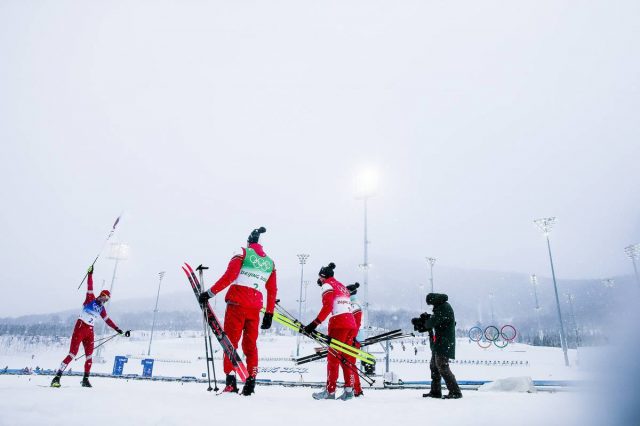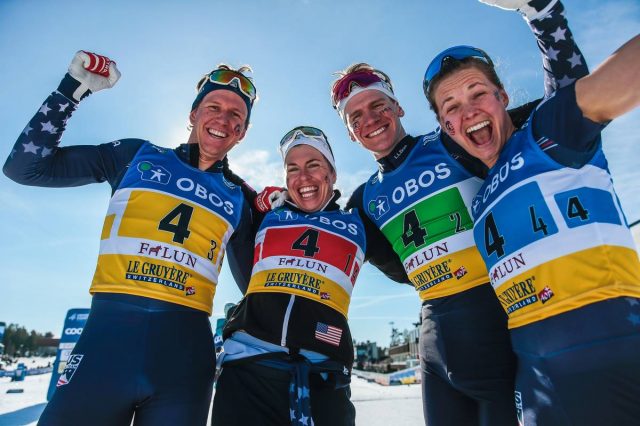Chris Grover is the U.S. Cross-Country Program Director. He has held that position for three years. He corresponded with FasterSkier’s Ken Roth in discussing the upcoming World Cup season, and an overview of the U.S. program. This is the second in a series of interviews with Mr. Grover.

FIS (International Ski and Snowboard Federation) has reaffirmed the Russian ban. How do participating athletes feel about it? Do they feel deprived not being able to compete against some of the top skiers? Are skiers talking about how it will affect competition outcomes?
Europeans tend to see this as a very black and white issue, that the Russians and Belarusians should not be able to compete while (the war) is happening. At the same time, the athletes recognize, for the most part, that this is something that is happening to the Russian and Belarusian athletes, and they aren’t involved in the military or geopolitics. We all feel sad for the athletes and servicemen that we know. There are definitely two sides to see on the issue.
From a competition viewpoint, people aren’t looking at like “I’ll ski harder because people are absent.” We’ve kind of gotten used to absent teams. We’ve missed Norwegians, Swedes, and Finns over the last two years due to Covid. It’s a similar situation. Our perspective is that this is our one opportunity to perform. We can’t control the pandemic or geopolitics. We focus on just having the best race possible.
FIS voted last spring to change to equal distances for men and women. This came after an athlete survey which didn’t support it. Did it come as a surprise? What’s been the impact for training and planning?
The change came around really fast. One of the people who really drove it was Vegard Ulvang (former FIS executive board chairperson). His perspective was that the original thinking of the design of the distances was “old thinking.” Are we going to change with the times or (be) dragged into the future?
It’s not surprising it wasn’t popular in the athlete survey. Athletes have grown up racing and training for certain distances. To change that is really hard for the athletes to envision. But, the practicality of the changes aren’t that big . . . It may seem dramatic, but in reality, it’s not as big as you would think.
Some of the discussion was around things such as television time. Should this be part of the discussion?
Now women will have more television time. But changes have happened so that men’s and women’s race times have gotten a lot closer. More importantly, if there’s more coverage devoted to the women, then that’s great. The women deserve more attention than they get. They’re incredible athletes and we need to build the interest in women’s racing . . . In the U.S. we’ve had female winter sport superstars for a long time. It’s been slower to come around in some places in Europe. Getting the women more coverage will be helpful.
With the change in distances, genders will also race on the same course. This will be an indirect positive impact. It saves the organizers lots of money. You can use the same television cameras, and the same snow. That will be really critical this year when it comes to energy costs related to snow production. That’s a serendipitous advantage.

Are the women psyched about racing the 50k Holmenkollen?
Yes and no, depending on the athlete. Jessie’s really excited for it. This race has been going for over 100 years; and it will be skating this year. For the first time ever, the women will get to do the big race. That’s really exciting. There’s going to be a woman who’s the first time winner of the 50 K Holmenkollen. History will be made. That’s pretty exciting to contemplate. The one challenge is it’s also a week after the World Championships.
FIS is still on the fluoro merry-go-round; announcing fluoro bans and then backing off a couple of times. Has this caused turmoil in planning? Has FIS cried wolf too many times to be taken seriously on this issue?
The biggest issue for us on this has been financial. Instead of a straight transition to fluoro free, we’re having to make two transitions. We have to go from the world of C8 fluoros to C6 (differing fluorocarbon chain lengths found in the waxes), which we’re in now, to then potentially fluoro free. Every transition costs a massive amount of money in terms of testing and buying wax. Last year we had a massive investment into C6 wax when the call was made that we weren’t going fluoro free and that C6 wax would be allowed. We have boxes full of C8s, and made the transition to C6s. Then if you transition to fluoro free, you now have a bunch of obsolete C6 wax. Last year we spent double our budget on wax because of this.
I think our service guys agree the FIS decision to delay was correct. The new testing devices just haven’t worked that great. No one wants an environment when there are ways to cheat the ski testing protocols. The technology isn’t there yet to support an even, fair playing field.
FIS had their hearts in the right place with the original decision on fluoro and thought the technology would be easier. Making a detection device is way more granular than you think. You have to allow a certain percentage of fluoros to be ok. There’s a certain amount in the background, and testing in the field is harder than testing in the lab. No one understood the amount of challenges involved.
Are people concerned about ski doping?
Oh yeah. We’re worried about the same bad actors that have in the past been associated with doping finding another way to cheat. That’s why everyone wants the technology to be fool-proof.
Will teams have confidence in the testing technology once it’s implemented?
Yes, because teams are involved in the process already. Over the last several years, nations were invited to try and fool the testing devices. The bad news is, we could fool it. We have had a number of World Cups, and will have several this season, where we bring skis into the venues to test the devices’ accuracy. You can get creative trying to fool the machines. Things like burying fluorocarbons, using different application methods, and different layering. Testing the devices has been a group effort of all the nations.
In the spring we’re also testing proposed protocols. That means when the skis are tested, and when they go into a control area. The protocol is to test before races. For races with multiple rounds (sprints) this means skis going into controlled areas and picking up skis. Sprints will particularly tricky. It’s not realistic to submit skis for testing four times.
Are false positives an issue?
We’re testing for that to. Technicians are testing the machines with skis that have fluoros and skis that don’t. But, that’s one of the reasons proposed testing will be before the race. There are still a lot of things to figure out. For example, if a ski tests positive can an athlete submit a second pair? If you detect fluorocarbon ahead of the race, there’s no disqualification, the skier is just not permitted to start. You definitely don’t want to test after the race. There are lots of issues with that. You don’t want to have a winner disqualified afterwards.

Will we see mixed gender racing?
Not at the world championships, but in the World Cup for sure, in mixed four by five relays. But, there will not be a mixed team sprint.
Additional thoughts you would like readers to know?
It’s going to be a really exciting season. Equal distances will be an interesting story in every race.
It’s going to be really exciting watching Jessie and Rosie battle for the overall championship. They’re at the height of their careers battling at the same time. It’s a huge gift to U.S. racing fans.
It’s also going to be exciting to watch all the emerging young talent we have. Another interesting story will be watching Julia Kern: she had a great last four to five weeks of her racing season last year.
The other neat story will be the two mixed team relays on the schedule.
There’s also been a push to cluster races at venues, so we’ll have a lot of three race day weekends. More events at every weekend brings more value to racing fans every weekend.
The teams have had a really good summer, so I’m really excited to see what everyone can do.




